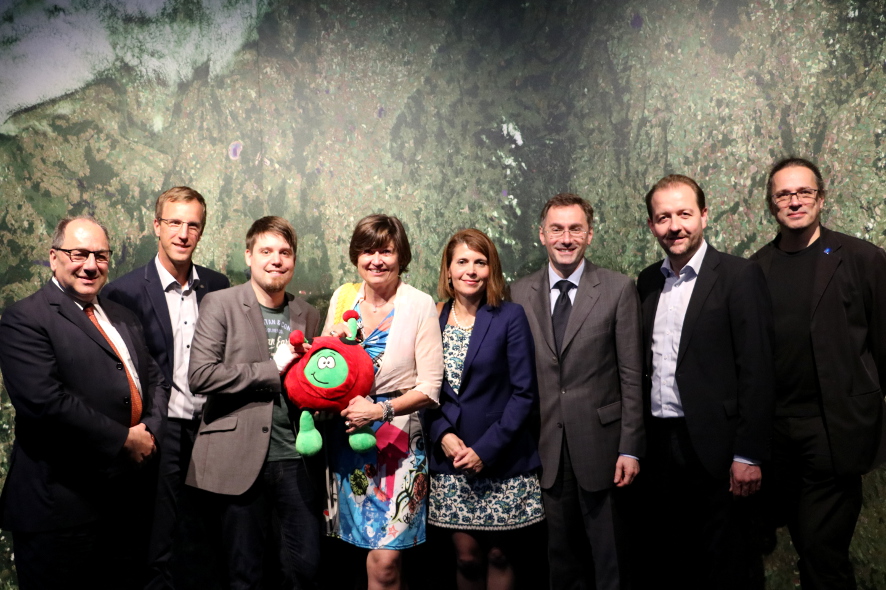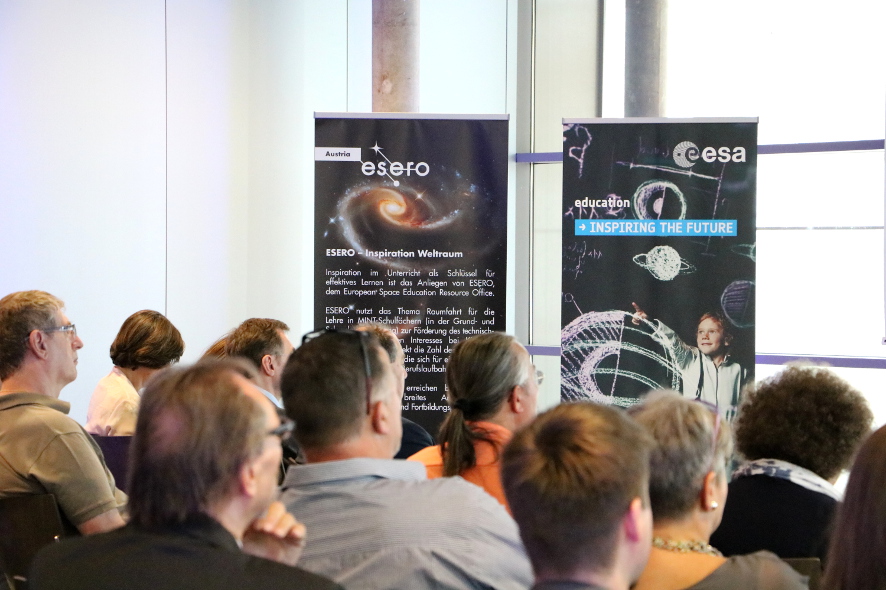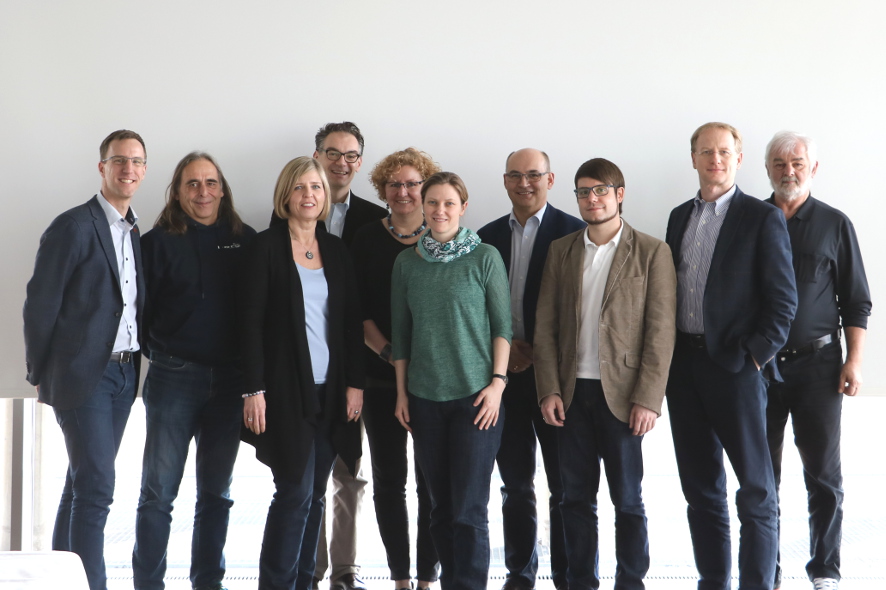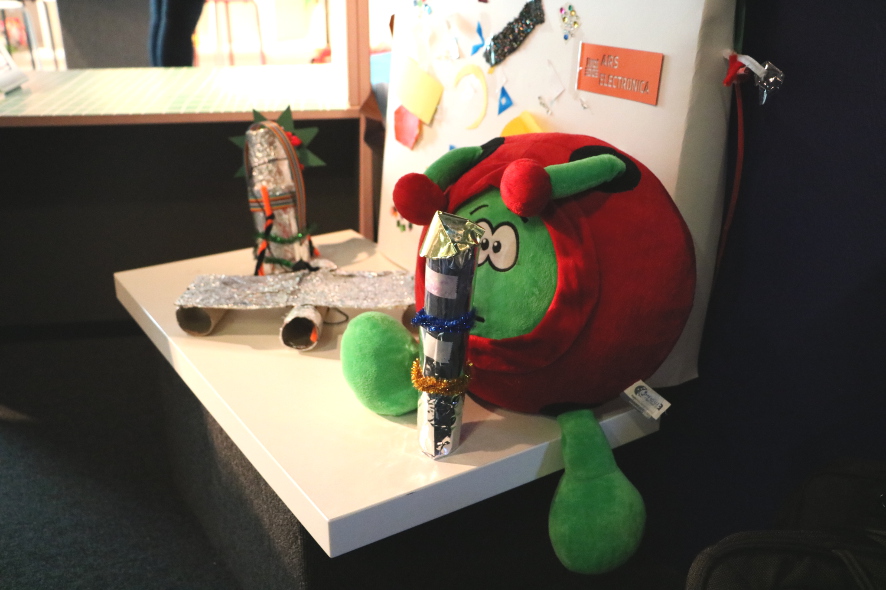Austria’s first European Space Education Resource Office opens today in the Ars Electronica Center! ESERO is a project of the European Space Agency (ESA) and its educational partners in various European countries. Its mission is to encourage interest on the part of kids and young people in scientific and technical subjects in the so-called STEM academic disciplines (science, technology, engineering and mathematics). Up to now, there were nine ESERO offices responsible for 12 countries. Now, for the first times, there’s an ESERO office in Austria too, and, following a protracted selection process, it’s located in the Ars Electronica Center.
The aim of the ESERO project is to integrate space research into classroom instruction as a means of fostering young people’s interest in mathematics, computer science, the natural sciences and technology. To achieve this goal, teachers are provided with knowhow and instructional materials that are custom-tailored to the specific curriculum requirements in the respective country. The job of each country’s ESERO office is to offer continuing professional education to teachers and to administer the materials.
In this interview, Clara Cruz Niggebrugge, ESERO Project Coordinator in the ESA Education Office, explains some of the ESERO office’s other activities, why the Ars Electronica Center was chosen as the host institution, and the reasoning behind the ESA’s ongoing efforts to nurture students’ encounters with the natural sciences and technical subjects.

Photo showing from left to right: Stellvertretender Sektionsleiter Ministerialrat Mag. Ingolf Schädler (Bundesministerium für Verkehr, Innovation und Technologie), Andreas Bauer (Leitung Ars Electronica Center, ESERO Österreich Supervisor), Michael Thaler (Ars Electronica Center Linz), Michaela Gitsch (FFG, Agentur für Luft- und Raumfahrt) Clara Cruz Niggebrugge (ESERO Project Coordinator), Prof. Dr. Kai-Uwe Schrogl, (Leiter ESA Strategy Department), Mag. Bernhard Baier (Vizebürgermeister der Stadt Linz, Aufsichtsratsvorsitzender Ars Electronica Linz GmbH), Gerfried Stocker ( Künstlerischer Leiter Ars Electronica).
The European Space Education Resource Office (ESERO) project was created by ESA’s Education Office 10 years ago. Can you please tell us a bit more about ESA’s Education Office?
Clara Cruz Niggebrugge: Since its creation more than 40 years ago, ESA is active in sharing the fascination of space with young people, with the objective of attracting them towards science and technology.
The ESA Education Office as such was created about 15 years ago and it has evolved a lot since then. Today ESA offers numerous training and learning opportunities targeting age groups from primary to university levels. The objective is to inspire the students in STEM disciplines (Science, Technology, Engineering and Mathematics), help them to enhance their scientific literacy and competences, and eventually help them to embark upon a STEM career, related to space in particular.
For the school age groups we try to reach as many students and teachers as possible, to break the stereotype that science and engineering are only for geniuses. We use space as a context for the teaching and learning of national STEM curricula. We start by training the teachers who, in their turn, acquire additional tools that can help them better inspire and engage their students. We also develop classroom resources and offer large-scale educational initiatives engaging students in hands-on experiences. By the time students arrive at university (up to PhD level) our ESA Academy initiative offers students a vast training and learning program where they learn the standard professional practices applied nowadays in the space sector. The students can complement and enhance their academic education by interacting with space experts, accessing professional space platforms, running real space projects, and benefitting from the direct transfer of ESA’s know how. In this way they are better prepared for a successful career in the space sector.

As you mentioned, the ESERO project uses European space exploration as a means of exciting young people about Science, Technology, Engineering and Mathematics (STEM). Why do you think is the topic of space exploration suitable for this purpose?
Space exploration and the intrinsic pioneering nature of space, feeding our ambition to discover and understand the Universe around us and mankind’s place in it, is a powerful source of inspiration for all, especially young people.
Young people are drawn to space. It provides a place big enough for their enormous imaginations and curiosity, signifying the future and the lives that lie before them. Using examples from space in the classroom to teach various subjects reinforces that space is not just a place of the imagination, whose promise gradually fades with time. Instead, it is a place that makes our everyday lives possible. In addition space is cross-curricular and encompasses an immense variety of disciplines, which means it is a very obvious and powerful topic to be used as a learning context.
The fall in students taking up classical science and engineering subjects is no secret, but why is ESA so keen to promote young people in STEM?
Modern societies strongly rely on the availability of advanced knowledge, innovation and continuously evolving technology for the efficient functioning of their economies. In particular, the Europe of today recognises the pivotal role of space in providing the knowledge base and the services required for its smart and sustainable growth. Today’s use of space technology for navigation, security and environmental monitoring ties us more tightly than ever to the space above our heads. One of Europe’s highest priorities is to reinforce research, innovation and education, in particular related to STEM fields, to guarantee its own future competitiveness.
STEM education in Europe has therefore a clear priority, and ESA, through its Education program, is contributing to make a difference and reverse this negative trend. ESA has a unique offer to STEM education ,providing access to exciting and real scientific data, expertise, scientific methodology, role models and state-of-the-art facilities across Europe.
In addition we know that space activity has an increasingly essential role in the life of citizens. The next generation of European citizens should grow up with the word ‘space’ on their lips. Even if they do not enter jobs in the space programme, they must know about Europe’s connection to space and the way it enhances all of our lives, from health, communication, navigation, safety etc.

First ESERO Austria meeting at Ars Electronica Center
What does it mean to be an ESERO office? What are the tasks? What happens in these offices?
ESERO (European Space Education Resource Office) is a collaboration project between ESA and national partners which started 10 years ago; it is ESA’s flagship project in support of primary and secondary school education in ESA’s Member States.
The secret of ESA’s ESERO approach is to inspire teachers first and offer them the means and material to inspire their pupils. ESERO’s objective is to demonstrate the ways in which space can be brought into the classroom and become a powerful, pedagogically modern and engaging teaching and learning tool. ESERO offices provide an offer which is truly tailored to each specific national school system, language, curricula and educational priorities in the STEM field. Space is used as a teaching and learning context rather than a subject which, as such, is hardly and rarely present in most school curriculums across Europe.
The key deliverables of an ESERO office are teacher training and classroom resources which fit the national needs. This means that the teacher trainings and classroom materials offered by each individual ESERO office respond to real needs (for example to make a specific curricular aspect more appealing and easier to learn and understand) and add real value. Through the ESEROs the awareness about the importance of space for society and about the diversity of space actors is also highly increased.
This is why when each new ESERO office starts we encourage them to do a first study about the national context and the national needs, highlighting the areas where ESERO can make real impact and support the STEM education in the countries. This reflection is extremely important every time new activities need to be developed. The ESERO offices aims at large scale reach, through solid national networks of partners which are active, accredited and re-known in the field of STEM education. This is only achieved by collaborating and levering on the combined expertise. ESEROs tend the become the “hub” for space education : promoting the best opportunities for teacher training and the best resources developed by themselves, ESA, and other space and STEM partners in the country.

Stellvertretender Sektionsleiter Ministerialrat Mag. Ingolf Schädler (Bundesministerium für Verkehr, Innovation und Technologie)
Today, on 22 June, 2016 the Austrian ESERO office will open at the Ars Electronica Centre. Why does the museum of the future perfectly fit as ESERO office?
Ars Electronica Centre is a fantastic museum and source of innovation in education. Art and scientific research are often driven by a similar spirit: investigating the nature of our being in the world, pushing boundaries in knowledge and technology, venturing into the domain of the unexplored.
Science centres and museums are exceptionally interesting places for teachers and students. They are a real source of inspiration, places of inquiry and discovery, experimentation and exploration. Sparking the interest of pupils often goes together with offering an emotional and sensorial experience that is able to trigger their curiosity – the first step in their learning process.
Hosted in Ars Electronica ESERO Austria will be utilize both the educational and scientific networks built around Ars Electronica Centre creating innovative learning strategies in partnership with an array of partners from both the STEM community and the Austrian space sector. This is extremely valuable. It will be very interesting to see the ESERO Austria grow and become more a part of the Austrian STEM landscape. We see a real opportunity with Ars Electronica Centre to offer a unique combination of didactic, science and technology expertise able to challenge the traditional way science is taught in school and to enable the application of innovative teaching/learning methodologies according to the new accredited trends in STEM pedagogy (learner-centred approach).
In addition the ESERO project in Austria will build on matching ESA’s educational objectives with the agenda of the Austrian government, which promotes the advancement of research and innovation.
We are confident that ESERO Austria will promote synergies and the federation of efforts between actors active in the field of space-related STEM Education and has the potential of becoming in the future a focal point for both schools and providers of space-related education resources and initiatives in the Austria.

The first ESERO started The Netherlands in 2006. Have you already registered remarkable successes with the ESERO?
The ESERO has been a success since the beginning but in the last years that we have real seen the real big impact and big growth. Of course it is already very good that ESEROs are present in 13 ESA Member States and we see a lot of interest in several other, including some of the larger size ESA Member States such as Germany and Italy.
As a consequence of the ESERO approach and intervention, the impact of usage of space as a context in the classroom has exceed expectations. ESERO classroom materials have won international awards. In addition teachers that received ESERO teacher training distinguished by excellence awards have mentioned how the ESERO trainings have contributed for their motivation and interest in improve their teaching in many ways.
Reports done by some of the ESEROs show that the ESERO project has empowered teachers to teach through science and research areas, even those they were initially less familiar with. In particular, they appreciate and understand space as a teaching and learning context: they actually start to want to teach it, see the value of teaching it. Space is proven as an inspiring context to deliver a more exciting and relevant curriculum for the 21st century. In synthesis, teachers have increased their motivation, knowledge and confidence in teaching STEM subjects.
Regarding the students, in 2015 about 143 970 primary and secondary school pupils have directed benefited in the classroom from the ESERO project. There is a reported engagement and enthusiasm (children consider space as one of the most inspirational subjects they can think of), increased confidence in scientific questioning and processes, positive change of attitudes – towards science and from the social point of view, higher attainment and well as raised awareness of self and job opportunities and increased personal aspirations.
